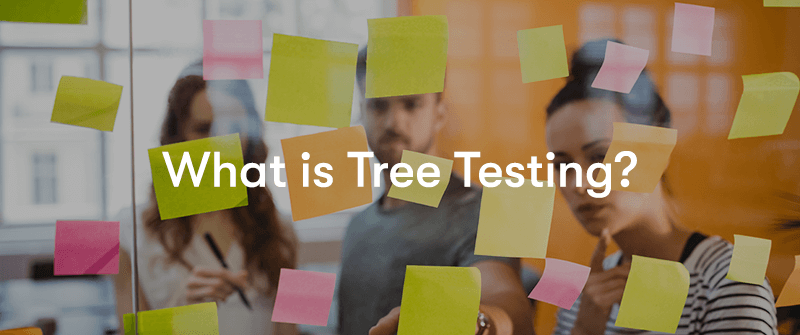What is Tree Testing for UX?
Welcome to the world of User Experience (UX) design, where the digital journey is finely crafted for users. In this landscape, UX tree testing shines as a vital tool for crafting seamless and intuitive digital experiences. Discover why tree testing is pivotal for evaluating information architecture and navigation structures, ensuring users can effortlessly find what they seek.
Explore the step-by-step process of conducting tree testing, from defining objectives to analysing results. Uncover the myriad benefits, from objective assessments to iterative improvements, that make tree testing indispensable for designers and stakeholders alike. Join us on this exploration of UX tree testing and its role in shaping user-centric digital landscapes.
What is Tree Testing?

Tree testing, also known as reverse card sorting or card-based tree testing, is a usability testing method used in information architecture and UX design. It helps evaluate the effectiveness of a website's or application's navigation structure, specifically the organisation of its content and menu structure. Tree testing is often conducted to ensure users can easily find the information they need within a digital product.
Why is Tree Testing Important for UX?

Tree testing helps ensure that the IA of a website or application is user-centric and efficient. By evaluating the organisation of content and menu structures, designers can create a more intuitive and logical layout that makes it easier for users to find what they need. Tree testing is not just important for optimising information architecture but for several other reasons, including:
Validating Navigation Design
It provides a way to validate navigation design decisions. This includes assessing the effectiveness of menu labels, the hierarchy of categories and subcategories, and the overall structure. Tree testing helps confirm whether users can easily understand and use the navigation system.
Enhancing Findability
One of the core goals of tree testing is to improve findability. Users should be able to locate the information or perform tasks they came for quickly. Effective IA design, validated through tree testing, contributes to higher findability, reducing frustration and enhancing the overall user experience.
Reducing Cognitive Load
A well-structured navigation system reduces the cognitive load on users. When information is logically organised, users don't have to think too hard about where to look for something. This makes their interaction with the product more efficient and enjoyable.
Iterative Improvement
Tree testing can be conducted iteratively throughout the design and development process. It allows designers to refine the IA based on user feedback, leading to continuous improvement. This iterative approach aligns with user-centred design principles, ensuring that the product meets the evolving needs of its audience.
Data-Driven Decision Making
Tree testing generates quantitative data about how users interact with the navigation structure. Designers and stakeholders can use this data to make informed decisions about changes and improvements. This data-driven approach reduces guesswork and subjectivity in design choices.
Cost-Effective Testing
Tree testing is relatively inexpensive compared to other usability testing methods that involve complex prototypes or extensive user interface designs. It can be conducted early in the design process, allowing issues to be identified and addressed before costly development work begins.
Reducing User Frustration
When users struggle to find what they're looking for, they can become frustrated and may abandon the website or application. Tree testing helps identify pain points in the navigation, enabling designers to eliminate obstacles and create a smoother, more user-friendly experience.
Aligning with User Expectations
Effective IA design aligns with users' mental models and expectations. Tree testing helps ensure that the structure and labelling of content match how users naturally think about and categorise information, reducing cognitive dissonance.
In summary, tree testing is a valuable tool in the UX designer's toolkit because it focuses on the fundamental aspect of usability: how users find and navigate content. By systematically evaluating and improving information architecture, designers can create digital products that are more user-friendly, efficient, and aligned with user needs and expectations.
How to do UX Tree Testing Step-by-Step

Conducting UX tree testing involves a series of steps to evaluate the effectiveness of a website's or application's information architecture and navigation structure. Here's a step-by-step guide on how to perform UX tree testing:
1. Define Your Objectives
Clarify the specific goals and objectives of the tree testing. What aspects of the information architecture and navigation do you want to evaluate or improve?
2. Select Your Test Participants
Identify and recruit a group of participants who represent your target audience. Ensure they are unfamiliar with the website or application being tested. Typically, you'll need 10-15 participants for meaningful results.
3. Prepare Your Tree Structure
Create a hierarchical diagram representing the current or proposed information architecture. This structure should include main categories, subcategories, and their relationships.
Use specialised software or tools designed for tree testing, such as Optimal Workshop, Treejack, or paper cards and a whiteboard.
4. Develop Task Scenarios
Define a set of realistic tasks or scenarios that participants should complete during the test. These tasks should align with common user goals and involve navigating the tree structure.
Each task should be clear, concise, and focused on a specific goal, such as finding information or completing an action.
5. Create Task Instructions
Write task instructions that provide participants with context and guidance for each task. Ensure the instructions are clear and unbiased, avoiding leading language that might influence participants' choices.
6. Conduct the Test
Invite participants to the testing session in person or remotely, depending on your preferred method.
Explain the purpose of the test and provide a brief overview of the tasks.
Ask participants to think aloud as they perform each task, sharing their thought processes, decisions, and any difficulties they encounter.
Present the participants with one task at a time and record their responses, including the paths they take within the tree structure and whether they successfully complete the task.
7. Collect Data
Record quantitative data, such as the success rate (the percentage of participants who completed each task) and the time it took for participants to complete each task.
Take notes on qualitative feedback and observations, including participants' comments, frustrations, and any issues encountered.
8. Analyse Results
Analyse the data to identify patterns, trends, and areas of concern. Look for common paths participants take, bottlenecks, and tasks with low success rates.
Pay attention to both quantitative metrics and qualitative insights, as they provide a comprehensive view of the user experience.
9. Generate Recommendations
Based on your analysis, generate actionable recommendations for improving the information architecture and navigation structure. Consider renaming categories, restructuring the hierarchy, or rephrasing menu labels.
10. Iterate and Test Again (Optional)
If substantial changes are made based on the initial tree test results, consider conducting additional tree testing sessions to validate the improvements.
11. Implement Changes
Collaborate with designers and developers to implement the recommended changes to the information architecture and navigation structure.
12. Monitor and Evaluate
After implementing the changes, monitor user behaviour and gather feedback to ensure the improvements have positively impacted the user experience.
By following these steps, you can effectively conduct UX tree testing to assess and enhance the usability and user-friendliness of your website or application's information architecture and navigation design.
What Does Tree Testing Help With?

Tree testing helps with several important aspects of UX design and website/application development:
Information Architecture Evaluation
Tree testing primarily assists in evaluating the effectiveness of a digital product's information architecture (IA). It helps ensure that the content is logically organised and that users can easily locate the necessary information.
Navigation Design
It helps designers assess the navigation structure, including the arrangement of categories and subcategories, menu labels, and the overall hierarchy. This ensures that users can intuitively navigate through the system.
Findability
Tree testing helps identify whether users can quickly and efficiently find specific pieces of information or complete tasks. Improving findability reduces user frustration and enhances the overall user experience.
User-Centred Design
Tree testing promotes a user-centred design approach by involving real users in the testing process. It ensures that the IA and navigation align with users' mental models and expectations.
Iterative Improvement
Tree testing can be conducted iteratively throughout the design and development process, allowing for continuous improvement. Designers can make adjustments based on user feedback to create a more user-friendly product.
Data-Driven Decision Making
It provides quantitative data on how users interact with the IA and navigation. This data allows designers and stakeholders to make informed decisions about changes and improvements, reducing guesswork.
Reducing Cognitive Load
Effective IA design, confirmed through tree testing, reduces the cognitive load on users. When information is logically organised, users don't have to think too hard about where to find what they're looking for, making their experience more straightforward and efficient.
Enhancing User Satisfaction
A well-structured IA and navigation system contribute to a more pleasant user experience. Users who can effortlessly find what they need are more likely to be satisfied with the product.
Cost-Efficient Testing
Tree testing is a cost-effective way to evaluate and improve IA and navigation compared to other usability testing methods that require complex prototypes or extensive design work.
Alignment with User Needs
By uncovering user preferences and pain points, tree testing ensures that the IA and navigation structure aligns with user needs, which is crucial for creating a product that users will find valuable and user-friendly.
Reducing User Frustration
When users can't find what they're looking for, they can become frustrated and may abandon a website or application. Tree testing helps identify and eliminate navigation obstacles, reducing user frustration.
Validation of Design Decisions
Tree testing validates design decisions related to the organisation of content and menu labels. It confirms whether the chosen structure and labelling resonate with users and meet their expectations.
In summary, tree testing is a valuable usability testing method that addresses many key UX design and development aspects. It provides insights into the effectiveness of information architecture and navigation, ultimately leading to improved user satisfaction and a more user-friendly digital product.
What Are Some Common Use of Tree Testing?
Tree testing is a versatile usability testing method that can be applied to various scenarios and projects in web design, software development, and information architecture. Here are some common use cases for tree testing:
Website Navigation Optimisation
Tree testing is often used to evaluate and improve the navigation structure of websites. It helps ensure that users can easily find content, products, or services by testing the organisation of categories and subcategories, menu labels, and the overall hierarchy.
Intranet and Enterprise Software
Organisations use tree testing to enhance the information architecture and navigation of their intranet portals and enterprise software systems. This ensures employees can efficiently access company resources, documents, and tools.
E-commerce Websites
E-commerce platforms frequently employ tree testing to optimise product categorisation, filtering options, and menu labels. Improving findability can lead to increased sales and customer satisfaction.
Content Management Systems (CMS)
Publishers and content creators use tree testing to refine the IA of content-heavy websites and CMS interfaces. It helps users locate articles, blog posts, and multimedia content.
Mobile App Navigation
Tree testing can be adapted for mobile applications to evaluate the navigation flow and menu structure, ensuring users can easily access features and content on smaller screens.
Software Application Design
Software developers use tree testing to assess the organisation of features and functionalities within desktop applications and web-based software. This helps users efficiently perform tasks and achieve their goals.
Government and Public Sector Websites
Government agencies and public sector organisations employ tree testing to improve the usability of their websites, making it easier for citizens to access important information and services.
E-learning Platforms
Educational institutions and e-learning platforms use tree testing to optimise the navigation and categorisation of courses, resources, and learning materials.
Library and Information Retrieval Systems
Libraries and digital repositories utilise tree testing to enhance the search and retrieval of documents, research papers, and other resources.
Intranet and Knowledge Management Systems
Companies and organisations with extensive internal knowledge bases or wikis employ tree testing to streamline access to documentation and knowledge resources.
Redesign Projects
When redesigning a website or application, tree testing helps assess the effectiveness of proposed changes to the information architecture and navigation compared to the existing structure.
Content Audits
Tree testing can be combined with content audits to evaluate the relevance and accessibility of existing content within a website or application, leading to content optimisation efforts.
Usability Testing Validation
After conducting usability testing on a live product, tree testing can be used to verify whether the recommended changes to the IA and navigation have indeed improved the user experience.
Global and Multilingual Websites
Organisations with global audiences may use tree testing to ensure that the IA and navigation are practical for users from different regions and language backgrounds.
Accessibility Improvements
Tree testing can be part of efforts to enhance the accessibility of digital products, ensuring that users with disabilities can navigate and access content effectively.
Tree testing is a valuable tool for any project where the organisation and accessibility of content and features play a crucial role in the user experience. It helps designers and developers create more user-friendly and efficient digital products by aligning the IA and navigation with user needs and expectations.
What Are the Benefits of Tree Testing?

Tree testing offers several benefits in usability testing and user experience research. Here are some of the key advantages:
Objective Assessment
Tree testing provides objective data on how users interact with a website or application's information architecture and navigation structure. This data helps reduce subjectivity in design decisions.
Early-Stage Usability Evaluation
It can be conducted early in the design process, even before the visual design is implemented. This allows designers to identify and address navigation issues before investing significant resources in development.
Cost-Effective
Tree testing is relatively cost-effective compared to other usability testing methods with prototypes or live websites. It doesn't require complex prototypes or extensive design work.
Quick Results
Tree testing sessions are typically shorter than other usability tests, making it possible to gather insights from a larger number of participants in a shorter time frame.
Quantitative Data
Tree testing generates quantitative data, including success rates and task completion times. This data is easy to analyse and can be used to make data-driven design decisions.
Identifies Navigation Issues
Tree testing helps pinpoint specific navigation issues, such as poorly labelled categories, suboptimal menu structures, and dead-end paths, making it easier to focus on areas that need improvement.
Iterative Improvement
The iterative nature of tree testing allows for ongoing information architecture and navigation refinement. Designers can test, make changes, and retest until the desired user experience is achieved.
User-Centred Design
Tree testing promotes a user-centred design approach by involving real users in the testing process. It ensures the information architecture aligns with users' mental models and expectations.
Enhanced Findability
Tree testing helps improve findability, making it easier for users to locate the information or complete the tasks they came for. This reduces user frustration and improves overall satisfaction.
Validation of Design Decisions
Tree testing validates design decisions related to the organisation of content and menu labels, confirming whether the chosen structure and labelling resonate with users and meet their expectations.
Cross-Platform and Multilingual Testing
Tree testing can be adapted for different platforms (websites, mobile apps) and languages, making it versatile for testing in various contexts and for diverse user groups.
Reduced User Frustration
By identifying and eliminating navigation obstacles, tree testing helps reduce user frustration, ultimately leading to a more positive user experience.
Improved ROI
By optimising the information architecture and navigation, tree testing can increase user engagement, conversions, and customer satisfaction, ultimately improving a digital product's return on investment (ROI).
Alignment with Accessibility
Tree testing can be used to assess and enhance the accessibility of a website or application, ensuring that users with disabilities can navigate and access content effectively.
Evidence-Based Decision Making
Tree testing provides evidence-based insights into how users interact with the product's navigation, allowing stakeholders to make informed decisions for improvements.
In summary, tree testing is a valuable usability testing method that offers numerous benefits for UX designers, researchers, and organisations. It helps create more user-friendly and efficient digital products by identifying and addressing information architecture and navigation issues based on real user interactions and data.
What Are the Disadvantages of Tree Testing?

While tree testing is a valuable usability testing method with several advantages, it also has some disadvantages and limitations to consider:
Limited Realism
Tree testing focuses solely on organising content and navigation structure, excluding visual design and interactive elements. As a result, it may not capture the full user experience, including aesthetics and interactivity.
Lack of Context
Tree testing doesn't provide context or simulate real-world scenarios like usability testing with prototypes or live websites can. Participants may approach tasks differently in a real usage context.
Task Isolation
Participants in tree testing are given individual tasks to complete in isolation. This approach doesn't account for complex user journeys or multitasking scenarios where users may perform multiple tasks in succession.
Limited Qualitative Insights
While tree testing can capture quantitative data (e.g., success rates, completion times), it may not provide rich qualitative insights into why users made certain choices or their overall emotional reactions.
Inability to Test Content Quality
Tree testing assesses the structure and organisation of content but does not evaluate its quality, relevance, or accuracy. Content quality issues may still exist even if the navigation is optimised.
Simplified Interaction
Tree testing often relies on simplified interactions, such as selecting categories and subcategories. It doesn't account for complex interactions like forms, search functionality, or dynamic content.
Limited Exploration
Participants in tree testing may not explore the full range of content and features on a website or application, as they are given specific tasks to complete. This means that some areas of the site may not be adequately tested.
Participant Bias
Participants' familiarity with tree testing and their technical proficiency can influence the results. Some users may perform better simply because they are more comfortable with the testing method.
Moderator Influence
In remote tree testing, participants are not moderated in real-time. While this can save time and resources, it also means that participants do not receive immediate guidance or clarification if they encounter confusion or issues.
Limited Accessibility Assessment
While tree testing can identify some navigation barriers, it may not comprehensively assess the accessibility of a digital product, including issues related to screen readers, keyboard navigation, or other accessibility features.
Potential for "Gamification" Effect
Participants may treat tree testing as a game or puzzle, which could lead to different behaviours than they would exhibit in an actual usage context.
Requires Adequate Test Preparation
Creating a well-structured tree test, defining tasks, and recruiting participants require careful preparation. If not done correctly, the test may yield unreliable results.
Interpretation Complexity
Analysing tree testing data and drawing meaningful insights may require information architecture and usability testing expertise. Interpreting results accurately can be challenging for some teams.
Despite these disadvantages, tree testing remains a valuable tool for assessing and optimising digital product information architecture and navigation. It is particularly useful when combined with other usability testing methods and research techniques to better understand the user experience.
Is Tree Testing Qualitative or Quantitative?
Tree testing primarily generates quantitative data, although it can also include some qualitative aspects. Here's a breakdown of the qualitative and quantitative aspects of tree testing:
Quantitative Data:
Success Rates: One of the key quantitative metrics in tree testing is the success rate. This measures the percentage of participants who successfully complete a given task within the navigation structure. It provides a clear, numerical indicator of task success.
Task Completion Time: Tree testing also records the time it takes for participants to complete tasks. This quantitative data can highlight whether specific tasks are more time-consuming than others, potentially indicating usability issues.
Path Analysis: Analysing participants' paths through the navigation structure can yield quantitative insights. You can identify common paths, dead ends, and deviations from the expected route.
Task Sequencing: By tracking the sequence of tasks participants attempt or the order in which they explore categories, you can gather quantitative data on user behaviour patterns.
Comparative Analysis: You can compare the success rates and completion times of different tasks or scenarios to identify which parts of the navigation structure are more or less effective.
Qualitative Data:
Participant Comments: While tree testing primarily focuses on quantitative metrics, it often includes a qualitative component where participants are encouraged to provide comments or think aloud as they complete tasks. These comments can offer qualitative insights into why participants made certain choices or expressed frustrations and preferences.
User Feedback: Participants may provide qualitative feedback about their overall experience, such as how easy or difficult they found the tasks, what they liked or disliked about the navigation, or any suggestions for improvement.
Confusion and Frustration: Qualitative data can help identify moments of confusion or frustration participants experienced during the test, shedding light on specific usability issues.
Task Insights: Qualitative comments can provide context for quantitative data. For example, if a participant completes a task but mentions finding it confusing, this qualitative feedback can help explain the quantitative data.
In summary, while tree testing is primarily quantitative in nature, it often incorporates a qualitative component through participant comments and feedback. This combination allows researchers and designers to gain a more comprehensive understanding of the user experience, combining numerical metrics with insights into user behaviour, preferences, and challenges.
How Many People Are Needed for Tree Testing?

The number of participants needed for tree testing depends on several factors, including the complexity of your website or application, the diversity of your user base, and your testing objectives. However, a common guideline is to aim for a minimum of 10 to 15 participants. Here's why:
Statistical Significance
Having at least 10 to 15 participants can provide statistically significant results for most usability testing purposes. This sample size is often considered adequate for identifying major usability issues and trends in the data.
Variety of Perspectives
With 10 to 15 participants, you can capture a range of perspectives and behaviours. This is important because different users may approach tasks and navigation in unique ways.
Resource Constraints
Usability testing, including tree testing, can be resource-intensive regarding time, budget, and personnel. Balancing the need for meaningful insights with available resources often leads to a sample size in this range.
Iterative Testing
If you plan to conduct multiple rounds of tree testing (which is common for iterative design and improvement), you can start with a smaller sample size for each round and gradually increase it as you address issues and refine the design.
Time Constraints
Tree testing can be a time-consuming process, especially when conducting in-person sessions. Smaller sample sizes may be more manageable within a specific timeframe.
Budget
The cost of recruiting and compensating participants can also be a limiting factor. A smaller sample size can help control these expenses.
However, it's essential to note that while 10 to 15 participants provide valuable insights, they may uncover only some possible usability issues. Some more specialised or rare cases might only become apparent with a larger sample size or additional usability testing methods.
Suppose your website or application is particularly complex or has a diverse user base. In that case, you might consider conducting multiple rounds of testing with different groups of participants to ensure you capture a broader range of user behaviours and preferences.
Ultimately, the number of participants should be determined based on your research goals, available resources, and the confidence level you need in the results. Remember that usability testing is an iterative process, and you can continue refining your design based on user feedback.
What is the Difference Between Tree Testing and Card Sorting for UX?

Tree testing and card sorting are two distinct usability testing methods commonly used in UX research, particularly for evaluating information architecture and navigation. They serve different purposes and focus on various aspects of the user experience. Here are the key differences between tree testing and card sorting:
Tree Testing:
Purpose: Tree testing is used to evaluate the effectiveness of an existing or proposed IA and navigation structure. It assesses how well users can find specific information or complete tasks within the given IA.
Method: In tree testing, participants are presented with a hierarchical diagram or tree structure representing the categories, subcategories, and relationships within the IA. They are then given a series of tasks and asked to navigate through the tree to find the information or complete the tasks.
Focus: Tree testing primarily focuses on the organisation and structure of content and navigation labels. It aims to determine whether users can efficiently locate information without the influence of visual design elements.
Quantitative: Tree testing generates quantitative data, such as success rates (the percentage of participants who successfully complete tasks) and task completion times. It provides numerical insights into the usability of the IA.
Sample Size: A typical tree testing session involves 10 to 15 participants, although the sample size can vary depending on the project's objectives and resources.
Card Sorting:
Purpose: Card sorting gathers insights into how users conceptualise and categorise content or items. It helps designers understand users' mental models and preferences for organising information.
Method: Participants are given a set of content items or cards with no predefined categories in card sorting. They are asked to categorise these items based on their understanding and preferences.
There are two main types: open card sorting (participants create their own categories) and closed card sorting (participants sort items into predefined categories).
Focus: Card sorting focuses on the user's perspective of how content should be grouped and labelled. It helps inform the creation of an effective IA by revealing users' expectations and mental models.
Qualitative: Card sorting primarily generates qualitative data in the form of categories created by participants and their explanations for their choices. It provides insights into users' thought processes and preferences.
Sample Size: Card sorting can involve a more significant number of participants, typically ranging from 20 to 30 or more, to capture a wider range of perspectives and preferences.
In summary, while tree testing and card sorting are valuable UX research methods for information architecture and navigation design, they serve different purposes and provide different insights. Tree testing assesses the usability and effectiveness of an existing IA structure, focusing on quantitative metrics. In contrast, card sorting explores how users think about and categorise content, emphasising qualitative feedback to inform the creation of an IA structure that aligns with user mental models. These methods can be used together in the UX design process to achieve a well-optimised IA and navigation system.
Where Can You Learn More About UX?
Our BCS Foundation Certificate in User Experience training course is perfect for anyone who wants to increase their knowledge of User Experience. The BCS User Experience course will teach you the UX methodology, best practices, techniques, and a strategy for creating a successful user experience. The course will cover the following topics:
- Guiding Principles.
- User Research.
- Illustrating The Context of Use.
- Measuring Usability.
- Information Architecture.
- Interaction Design.
- Visual Design.
- User Interface Prototyping.
- Usability Evaluation.
Click the button below to find out more.

Final Notes on Tree Testing for UX
Through meticulous evaluation of information architecture and navigation structures, it empowers designers and developers to create digital ecosystems that seamlessly guide users to their destinations. With a focus on quantitative data, tree testing provides concrete insights into the effectiveness of website structures, improving findability and reducing user frustration.
By championing user-centric design, it fosters interfaces that align seamlessly with user expectations, resulting in elevated user satisfaction and engagement. In the ever-evolving landscape of UX, tree testing stands as a cornerstone, ensuring digital products deliver on the promise of an intuitive, user-friendly journey.



